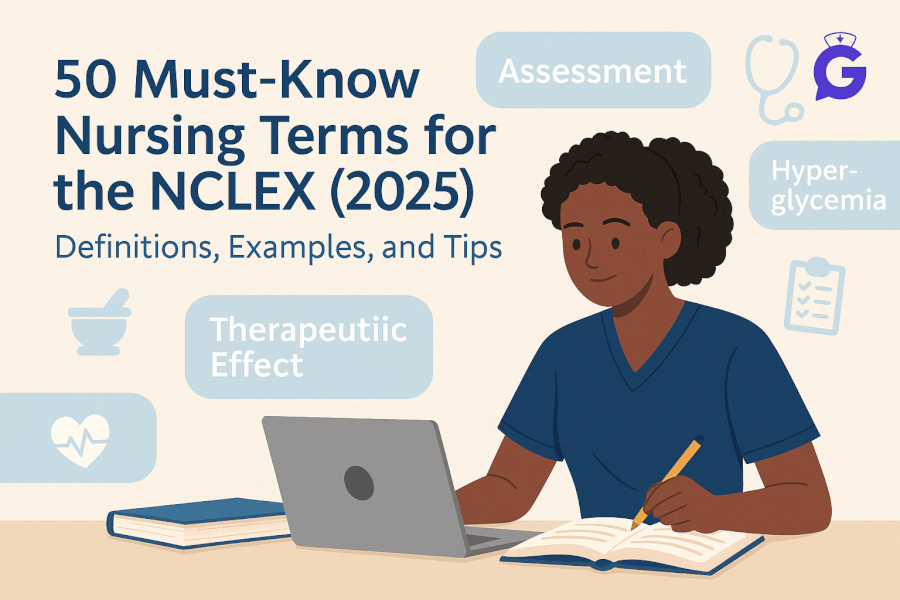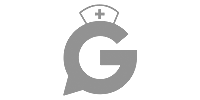50 Must-Know Nursing Terms for the NCLEX (2025): Definitions, Examples, and Quick Tips
If you're preparing for the NCLEX in 2025, mastering key nursing terminology isn't optional—it's essential. These terms show up in questions, case studies, and clinical scenarios, and they form the backbone of safe, effective nursing practice. This guide will walk you through 50 essential terms, complete with clear definitions, examples, and tips to remember them.
Why Vocabulary Matters for NCLEX
The NCLEX doesn't just test your memory—it evaluates your clinical judgment. If you don’t understand what a term means, you can’t apply it. Vocabulary is foundational. It’s the language the test speaks.
Let’s dive into the 50 most critical nursing terms to know for the NCLEX in 2025.
Nursing Process Terms
-
Assessment – Collecting patient data through observation, interview, and physical exam.
Tip: Always assess before you act! -
Diagnosis – Analyzing assessment data to determine health issues.
Example: "Risk for falls" is a common nursing diagnosis. -
Planning – Creating measurable goals based on the diagnosis.
Example: "Patient will ambulate 50 feet within 3 days." -
Implementation – Carrying out nursing interventions.
Tip: This is where you take action. -
Evaluation – Determining if goals were met and adjusting care if needed.
Patient Safety & Infection Control
-
Standard Precautions – Basic infection prevention applied to all patients.
Includes hand hygiene, gloves, masks, etc. -
Airborne Precautions – Measures for diseases like TB or measles.
N95 mask required. -
Droplet Precautions – Used for illnesses like influenza.
Surgical mask and gloves. -
Contact Precautions – For infections like MRSA or C. diff.
Gown and gloves needed. -
Asepsis – Absence of harmful microorganisms.
Tip: "Medical asepsis" = clean. "Surgical asepsis" = sterile.
Common Pathophysiology Terms
- Ischemia – Lack of blood supply to tissue.
- Edema – Swelling from fluid accumulation.
- Hypoxia – Low oxygen in tissues.
- Hyperglycemia – High blood sugar.
- Hypokalemia – Low potassium levels.
- Sepsis – Life-threatening organ dysfunction from infection.
- Dyspnea – Difficulty breathing.
- Bradycardia – Heart rate under 60 bpm.
- Tachycardia – Heart rate over 100 bpm.
- Hypertension – High blood pressure (typically >140/90 mmHg).
Pharmacology & Med Administration
- Therapeutic Effect – Desired result of a drug.
- Side Effect – Predictable but unwanted effect.
- Adverse Reaction – Unintended, harmful response.
- Contraindication – Reason to avoid a treatment.
- Bioavailability – Amount of drug that enters circulation.
- Half-Life – Time for drug concentration to decrease by half.
- PRN – As needed (e.g., pain meds).
- STAT – Immediately.
- TID – Three times a day.
- IV Push – Rapid injection directly into the bloodstream.
Legal & Ethical Concepts
- Informed Consent – Patient agrees to treatment after full disclosure.
- Negligence – Failing to act as a reasonable nurse would.
- Malpractice – Professional negligence causing harm.
- Battery – Touching without consent.
- Autonomy – Patient’s right to make their own decisions.
- Confidentiality – Protecting patient information (HIPAA!).
Mental Health & Psychosocial
- Delirium – Sudden, reversible confusion.
- Dementia – Gradual, progressive cognitive decline.
- Hallucination – False sensory perception.
- Anxiety – Uneasy feeling of uncertainty.
- Coping Mechanisms – Strategies to manage stress.
- Therapeutic Communication – Purposeful interaction that promotes patient well-being.
Labs & Fluids
- BUN (Blood Urea Nitrogen) – Measures kidney function.
- Creatinine – Waste product indicating renal health.
- Hematocrit – % of RBCs in blood.
- WBC Count – Indicator of infection or immune status.
- Serum Osmolality – Measures concentration of solutes in blood.
- pH – Normal range: 7.35–7.45. Indicates acid-base status.
- ABGs – Arterial blood gases; measures oxygen, CO2, and pH.
- Electrolytes – Sodium, potassium, calcium, and chloride levels.
Study Tips to Master These Terms
- Make Flashcards – Use paper or apps like Anki or Quizlet.
- Use Mnemonics – RICE (Rest, Ice, Compression, Elevation), MONA (Morphine, Oxygen, Nitrates, Aspirin).
- Teach a Friend – If you can explain it, you understand it.
- Practice Questions – Use NCLEX-style practice with rationales.
Final Thoughts
These 50 terms are just the beginning—but they represent the core of nursing language. Knowing them gives you an edge, not just for the NCLEX but for real-world practice.
For more deep dives into nursing topics, check out:
- The Ultimate Nursing Vocabulary and Key Concepts Guide (2025)
- Pharmacology Mnemonics and Drug Terms
- NCLEX Cheat Sheet: Must-Know Labs and Ranges
- Psychosocial Terms Made Easy
Keep learning, keep reviewing, and you’ll be ready to conquer the NCLEX.
Want a printable version of this list? Visit goodnurse.com for downloadable study tools and more NCLEX prep resources.







